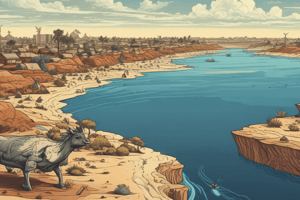Podcast
Questions and Answers
What is the primary driver behind rising sea levels?
What is the primary driver behind rising sea levels?
Which of the following is NOT a consequence of climate change?
Which of the following is NOT a consequence of climate change?
Which strategy is essential for reducing greenhouse gas emissions?
Which strategy is essential for reducing greenhouse gas emissions?
What role do forests play in combatting climate change?
What role do forests play in combatting climate change?
Signup and view all the answers
What is essential for communities to effectively adapt to climate change impacts?
What is essential for communities to effectively adapt to climate change impacts?
Signup and view all the answers
What is a significant effect of climate change on human health?
What is a significant effect of climate change on human health?
Signup and view all the answers
Which agricultural practice is highlighted as crucial for food security amid climate change?
Which agricultural practice is highlighted as crucial for food security amid climate change?
Signup and view all the answers
What type of investments are required to protect coastal communities from climate change effects?
What type of investments are required to protect coastal communities from climate change effects?
Signup and view all the answers
Why is international cooperation vital in addressing climate change?
Why is international cooperation vital in addressing climate change?
Signup and view all the answers
Which statement describes a significant political challenge related to climate change adaptation?
Which statement describes a significant political challenge related to climate change adaptation?
Signup and view all the answers
Study Notes
Global Warming
- Refers to the increase in average temperatures across Earth's surface over time
- Measured over a period of at least one year
Climate Change
- Refers to long-term shifts in global weather patterns and temperatures
- Caused by increased energy in the Earth's system brought on by global warming
Consequences of Climate Change
- Rising sea levels: Melting glaciers and ice sheets contribute to rising sea levels.
- Extreme weather events: Increased frequency and severity of events like hurricanes, heatwaves, wildfires, droughts, floods, and heavy precipitation.
- Impact on ecosystems and biodiversity: Changes in temperature, precipitation, and ocean acidification disrupt ecosystems and threaten species.
- Threats to human health: Increased heat-related illnesses, respiratory problems, and the spread of infectious diseases.
- Food and water security: Reduced crop yields and increased food insecurity due to changes in climate.
Addressing Climate Change
- Transitioning to renewable energy sources: Shift from fossil fuels to solar, wind, and hydropower to reduce greenhouse gas emissions.
- Improving energy efficiency: Reducing energy consumption through improvements in buildings, transportation, and industry.
- Protecting and restoring forests: Forests absorb carbon dioxide from the atmosphere.
- Adapting to climate impacts: Implementing measures like flood control, drought-resistant crops, and early warning systems to mitigate climate effects.
Policy Issues Related to Climate Change
Greenhouse Gas Emissions Reduction
- Setting targets and timelines: Determining the appropriate level of emissions reduction and creating realistic timelines for achieving these goals is essential.
- Policy instruments for emissions reduction: Various methods, such as carbon taxes and cap and trade systems, can be used to reduce emissions.
- International cooperation: Addressing climate change effectively requires collaboration on a global level, as emissions are a global concern.
Adapting to Climate Change Impacts
- Investing in infrastructure resilience: Adapting to rising sea levels, extreme weather, and water scarcity through investments in resilient infrastructure is crucial for communities.
- Developing climate-smart agriculture: Implementing sustainable practices, like drought-resistant crops and water-efficient irrigation, to ensure food security in the face of climate change.
- Managing coastal areas: Protecting coastal communities from rising sea levels and storms requires investment in seawalls, flood defenses, and relocation strategies.
Studying That Suits You
Use AI to generate personalized quizzes and flashcards to suit your learning preferences.
Description
This quiz covers the critical concepts of global warming and climate change, including their definitions, causes, and consequences. Explore the impact of rising sea levels, extreme weather events, and threats to human health and food security. Test your knowledge on how climate change affects ecosystems and biodiversity.



